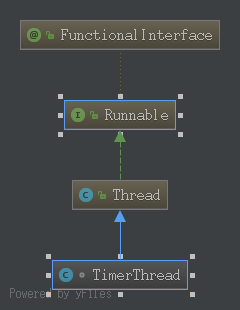首先来看一下Timer类
例子如下:
1 package cn.concurrent.executor; 2 3 import java.util.Timer; 4 import java.util.TimerTask; 5 6 /** 7 * Created by spark on 17-9-25. 8 */ 9 public class TestTimer { 10 11 12 static class Reminder { 13 Timer timer; 14 15 public Reminder(int sec) { 16 timer = new Timer(); 17 timer.schedule(new TimerTask() { 18 @Override 19 public void run() { 20 System.out.println("this is Timer."); 21 timer.cancel(); 22 } 23 }, sec * 1000); 24 } 25 } 26 27 public static void main(String[] args) { 28 System.out.println("------------------"); 29 new Reminder(5); 30 System.out.println("。。。。。。。。。。"); 31 } 32 }
运行结果如下:
------------------
..................
this is timer.
Process finished with exit code 0
运行后,前2行很快就会输出,第三行5秒后出现。
从这个例子可以看出一个典型的利用timer执行计划任务的过程如下:
- new一个TimerTask的子类,重写run方法来指定具体的任务
- new一个Timer类,Timer.schedule(TimerTask),来运行具体的定时任务。
- 调用相关调度方法执行计划。这个例子调用的是schedule方法。
- 任务完成,结束线程。这个例子是调用cancel方法结束线程。
JDK源码来看一下:
1 public void schedule(TimerTask var1, long var2) { 2 if(var2 < 0L) { 3 throw new IllegalArgumentException("Negative delay."); 4 } else { 5 this.sched(var1, System.currentTimeMillis() + var2, 0L); 6 } 7 } 8 9 public void schedule(TimerTask var1, Date var2) { 10 this.sched(var1, var2.getTime(), 0L); 11 } 12 13 public void schedule(TimerTask var1, long var2, long var4) { 14 if(var2 < 0L) { 15 throw new IllegalArgumentException("Negative delay."); 16 } else if(var4 <= 0L) { 17 throw new IllegalArgumentException("Non-positive period."); 18 } else { 19 this.sched(var1, System.currentTimeMillis() + var2, -var4); 20 } 21 } 22 23 public void schedule(TimerTask var1, Date var2, long var3) { 24 if(var3 <= 0L) { 25 throw new IllegalArgumentException("Non-positive period."); 26 } else { 27 this.sched(var1, var2.getTime(), -var3); 28 } 29 } 30 31 public void scheduleAtFixedRate(TimerTask var1, long var2, long var4) { 32 if(var2 < 0L) { 33 throw new IllegalArgumentException("Negative delay."); 34 } else if(var4 <= 0L) { 35 throw new IllegalArgumentException("Non-positive period."); 36 } else { 37 this.sched(var1, System.currentTimeMillis() + var2, var4); 38 } 39 } 40 41 public void scheduleAtFixedRate(TimerTask var1, Date var2, long var3) { 42 if(var3 <= 0L) { 43 throw new IllegalArgumentException("Non-positive period."); 44 } else { 45 this.sched(var1, var2.getTime(), var3); 46 } 47 } 48 49 private void sched(TimerTask var1, long var2, long var4) { 50 if(var2 < 0L) { 51 throw new IllegalArgumentException("Illegal execution time."); 52 } else { 53 if(Math.abs(var4) > 4611686018427387903L) { 54 var4 >>= 1; 55 } 56 57 TaskQueue var6 = this.queue; 58 synchronized(this.queue) { 59 if(!this.thread.newTasksMayBeScheduled) { 60 throw new IllegalStateException("Timer already cancelled."); 61 } else { 62 Object var7 = var1.lock; 63 synchronized(var1.lock) { 64 if(var1.state != 0) { 65 throw new IllegalStateException("Task already scheduled or cancelled"); 66 } 67 68 var1.nextExecutionTime = var2; 69 var1.period = var4; 70 var1.state = 1; 71 } 72 73 this.queue.add(var1); 74 if(this.queue.getMin() == var1) { 75 this.queue.notify(); 76 } 77 78 } 79 } 80 } 81 }
核心方法是 sched(),最终会把任务放入一个TaskQueue的队列中,然后来执行。
默认情况下,创建的timer线程会一直执行,主要有下面四种方式来终止timer线程:
- 调用timer的cancle方法
- 把timer线程设置成daemon线程,(new Timer(true)创建daemon线程),在jvm里,如果所有用户线程结束,那么守护线程也会被终止,不过这种方法一般不用。
- 当所有任务执行结束后,删除对应timer对象的引用,线程也会被终止。
- 调用System.exit方法终止程序
代码如下:
1 public void cancel() { 2 TaskQueue var1 = this.queue; 3 synchronized(this.queue) { 4 this.thread.newTasksMayBeScheduled = false; 5 this.queue.clear(); 6 this.queue.notify(); 7 } 8 }
没有显式的线程stop方法,而是调用了queue的clear方法和queue的notify方法,clear是个自定义方法,notify是Objec自带的方法,很明显是去唤醒wait方法的。
1 void clear() { 2 for(int var1 = 1; var1 <= this.size; ++var1) { 3 this.queue[var1] = null; 4 } 5 6 this.size = 0; 7 }
原理是清空正个队列(底层是一个数列)。
看一下Timer的构造器:
1 public Timer(String var1) { 2 this.queue = new TaskQueue(); 3 this.thread = new TimerThread(this.queue); 4 this.threadReaper = new Object() { 5 protected void finalize() throws Throwable { 6 synchronized(Timer.this.queue) { 7 Timer.this.thread.newTasksMayBeScheduled = false; 8 Timer.this.queue.notify(); 9 } 10 } 11 }; 12 this.thread.setName(var1); 13 this.thread.start(); 14 }
里面维护一个线程,然后看一下这个线程,如下:

继承Thread类,重写run()方法,看看run()方法的逻辑:
1 public void run() { 2 boolean var9 = false; 3 4 try { 5 var9 = true; 6 this.mainLoop(); 7 var9 = false; 8 } finally { 9 if(var9) { 10 TaskQueue var4 = this.queue; 11 synchronized(this.queue) { 12 this.newTasksMayBeScheduled = false; 13 this.queue.clear(); 14 } 15 } 16 } 17 18 TaskQueue var1 = this.queue; 19 synchronized(this.queue) { 20 this.newTasksMayBeScheduled = false; 21 this.queue.clear(); 22 } 23 }
看到调用了一个方法mainLoop();其他的操作都是初始化TaskQueue,并清空TaskQueue.
看一下mainLoop()方法。如下:
1 private void mainLoop() { 2 while(true) { 3 while(true) { 4 try { 5 TaskQueue var3 = this.queue; 6 TimerTask var1; 7 boolean var2; 8 synchronized(this.queue) { 9 while(this.queue.isEmpty() && this.newTasksMayBeScheduled) { 10 this.queue.wait(); 11 } 12 13 if(this.queue.isEmpty()) { 14 return; 15 } 16 17 var1 = this.queue.getMin(); 18 Object var8 = var1.lock; 19 long var4; 20 long var6; 21 synchronized(var1.lock) { 22 if(var1.state == 3) { 23 this.queue.removeMin(); 24 continue; 25 } 26 27 var4 = System.currentTimeMillis(); 28 var6 = var1.nextExecutionTime; 29 if(var2 = var6 <= var4) { 30 if(var1.period == 0L) { 31 this.queue.removeMin(); 32 var1.state = 2; 33 } else { 34 this.queue.rescheduleMin(var1.period < 0L?var4 - var1.period:var6 + var1.period); 35 } 36 } 37 } 38 39 if(!var2) { 40 this.queue.wait(var6 - var4); 41 } 42 } 43 44 if(var2) { 45 var1.run(); 46 } 47 } catch (InterruptedException var13) { 48 ; 49 } 50 } 51 } 52 }
可以看到wait方法,之前的notify就是通知到这个wait,然后clear方法在notify之前做了清空数组的操作,所以会break,线程执行结束,退出。
schedule VS. scheduleAtFixedRate
这两个方法都是任务调度方法,他们之间区别是,schedule会保证任务的间隔是按照定义的period参数严格执行的,如果某一次调度时间比较长,那么后面的时间会顺延,保证调度间隔都是period,而scheduleAtFixedRate是严格按照调度时间来的,如果某次调度时间太长了,那么会通过缩短间隔的方式保证下一次调度在预定时间执行。举个栗子:你每个3秒调度一次,那么正常就是0,3,6,9s这样的时间,如果第二次调度花了2s的时间,如果是schedule,就会变成0,3+2,8,11这样的时间,保证间隔,而scheduleAtFixedRate就会变成0,3+2,6,9,压缩间隔,保证调度时间。